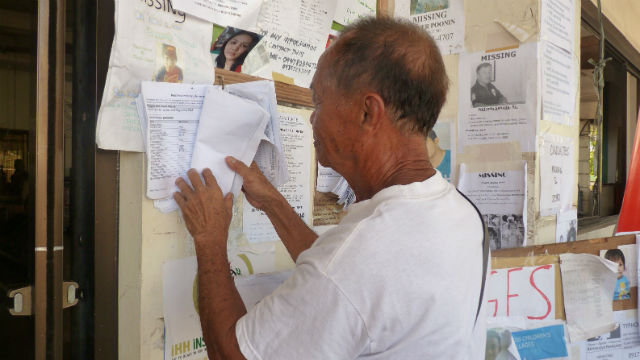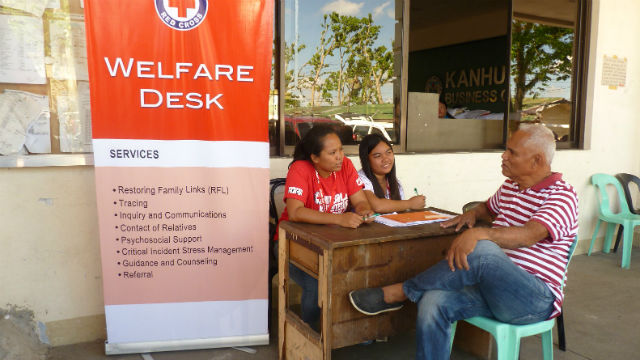SUMMARY
This is AI generated summarization, which may have errors. For context, always refer to the full article.

TACLOBAN CITY, Philippines – Everyday, Antonio Claridad, 72, checks the lists and goes through the names, one by one. Today might be the day that he will get word about his cousin, Reming Natulya.
“They said she died,” said Claridad in Tagalog, adding that Natulya and her family lived some 200 meters away from the shoreline of San Jose, a coastal village in Tacloban. San Jose was one of those towns totally destroyed by Super Typhoon Yolanda (Haiyan).
The last time he saw her was sometime last September during the feast of San Isidro. “Her daughter who lives in Los Angeles is the one asking me to keep looking for her. She heard somehow that her mother was among the dead. She wants to come home to bury her mother.”
“Kung patay na nga si Reming,” he said slowly, looking away. “Tanggap na namin. Gusto lang sana naming malaman.” (If Reming is dead, we can accept that. We just want to know.)
Looking for the missing

Everyday, the International Committee of the Red Cross (ICRC) Restoring Family Links delegate Elaine Chan and the Philippine Red Cross (PRC) team go through tracing requests and head off to the field and visit the communities in the Yolanda-affected areas that are the last known address of the missing. Their leads are name, age, birthday and last known address of the missing person.
“When we reach the village, the first person we usually look for is the barangay captain (community chief). He can tell us if he knows the family members or people who might know the missing,” said Chan.
They use basic rudimentary methods which still work best in the field – shouting announcements over a megaphone, knocking from door-to-door, and asking those who have survived if they know anything about the person missing.
Leads may turn up, bits of information may lead them to another place, another village; perhaps, another step closer to reuniting the missing with their families. When they get lucky, the teams are able to locate the missing person or a family member and then try to immediately call the enquirer.
Restoring family links
The ICRC’s work to restore family links goes back to 1870, when it obtained lists of French prisoners held by German forces, and could then reassure the families. Since then, tracing people separated by conflict and disaster has become a major part of the ICRC’s protection work. It involves the international Red Cross and Red Crescent Movement in a global network.
Through the years, SMS messaging, social media and applications like Google’s Person Finder have provided a platform for quick feedback and mass transmission of information to people.
“People can file a missing person report on our restoring family links website,” explained Chan. The website offers two primary services: registration and search.
You can register people with whom you have lost contact, register your own name so that other people can see that you are alive (I’m alive list) and search through the list of missing persons and people who have reported that they are alive. Copies of these lists are also posted in public buildings, evacuation centers and radio stations in the affected areas as Internet connection is still an issue.
First Responder Radio, which set up emergency communications in Tacloban, reads portions of the list during live broadcast. At the PRC Welfare Desk, stationed outside public buildings (usually the city or municipal hall), a missing persons report may also be filed.
“Sometimes, a search turns out successful. A missing family member is found and with the contact number provided by the one who initiated the search, we connect them through a satellite phone.”
When a search turns up with nothing, the Tracing Team will check records in the evacuation centers, and check injury and death lists in hospitals.
Yolanda’s challenge
Typhoon Yolanda was a particularly challenging case because of the large number of queries that came in from all over the world. At the onset of the typhoon, the PRC website received more than 35,000 requests and inquiries.
Later, some survivors left by air onboard C130s, logging only their names in record books. Without a minimum of identification details like full name, age, date of birth and last known address, the Red Cross Teams cannot proceed with tracing.
Now, two months after Yolanda, with communication and mobile networks partially restored, some people have already been reunited with their families, some have found their dead and buried them.
The ICRC and the PRC have on record some 350 active missing persons cases. However, the reality remains that because of the nature of the disaster and the challenges related to the management of dead bodies – a typhoon where bodies were washed away – finding and identifying all the dead bodies will not be possible.
Without a body to positively identify, the person is considered still missing. “If we cannot identify the dead bodies, we also cannot locate the missing person,” PRC social services officer Beverly Kalingag said.
Two months after, the search goes on for the Red Cross Tracing Team and others like Claridad.
Many like Claridad continue to hope against the odds that their relatives are merely lost but still alive, others simply want a body to bury. They long to say good-bye and lay their loved ones to rest. Everyday they look, everyday they try to quell the nagging hope, the anguish of wondering what if, and hope to finally attain the comfort of closure. – Rappler.com
Add a comment
How does this make you feel?
There are no comments yet. Add your comment to start the conversation.